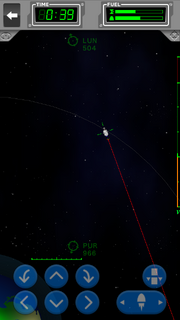Overview[]

An Apollo Service Module with a Crew Capsule Dockable crosses into the COI of HOM.
In gameplay, every planet has a circle of influence (hereafter referred to as COI), which is the circular area containing it. This is bounded by a grey circle centered on the planet, and any Object that crosses into the circle is subject to the gravity of the planet.
A spacecraft, space station, or some other Object achieves a stable orbit if it has sufficient velocity (indicated by a brightened green section of the velocity gauge). The Object "falls" towards the planet if the velocity is too low (i.e., only the orange section of the velocity gauge is lit). It leaves orbit following the red exit line if the velocity of the Object is greater than the escape velocity (represented by the marking between the red and green sections of the velocity gauge) of the planet. On the other hand, if the velocity gauge moves into the red, attempting to enter orbit causes the Object to perform a slingshot maneuver; that is, it gains speed for some time, slows down, and escapes the COI facing a different direction.
In missions you can find a white circle around a station. It is not a circle of influence, but a line, which will give you a failure if you will take the station from it.
Trivia[]
- Technically, the circle defining the boundary of a COI isn't a (perfect) circle but a regular polygon.
- In reality, the magnitude of the gravitational pull of a planetary body is proportional to distance. This is difficult to portray in game mechanics, so every planet is simply depicted having a COI in-game.
- In astronomy, "sphere of influence" describes it well (but not in terms of mathematics).
- In the generality of physics, the greater the mass of a planet, the stronger the gravity of that planet is; therefore, the farther its gravity affects, e.g., the gravitational field of Jupiter is clearly stronger and larger than that of the Moon.
